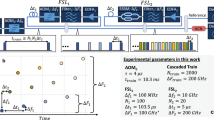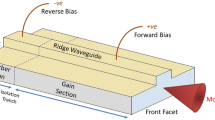Abstract
Challenging applications in trace gas measurements require low uncertainty and high acquisition rates1,2,3,4. Many cavity-enhanced spectroscopies exhibit significant sensitivity and potential5,6, but their scanning rates are limited by reliance on either mechanical or thermal frequency tuning7. Here, we present frequency-agile, rapid scanning spectroscopy (FARS) in which a high-bandwidth electro-optic modulator steps a selected laser sideband to successive optical cavity modes. This approach involves no mechanical motion and allows for a scanning rate of 8 kHz per cavity mode, a rate that is limited only by the cavity response time itself. Unlike rapidly frequency-swept techniques8,9,10,11, FARS does not reduce the measurement duty cycle, degrade the spectrum's frequency axis or require an unusual cavity configuration. FARS allows for a sensitivity of ∼2 × 10−12 cm−1 Hz−1/2 and a tuning range exceeding 70 GHz. This technique shows promise for fast and sensitive trace gas measurements and studies of chemical kinetics.
This is a preview of subscription content, access via your institution
Access options
Subscribe to this journal
Receive 12 print issues and online access
$209.00 per year
only $17.42 per issue
Buy this article
- Purchase on Springer Link
- Instant access to full article PDF
Prices may be subject to local taxes which are calculated during checkout


Similar content being viewed by others
References
Chen, H. et al. High-accuracy continuous airborne measurements of greenhouse gases (CO2 and CH4) using the cavity ring-down spectroscopy (CRDS) technique. Atmos. Meas. Tech. 3, 375–386 (2010).
Risby, T. H. & Solga, S. F. Current status of clinical breath analysis. Appl. Phys. B 85, 421–426 (2006).
Hinkov, B. et al. Time-resolved spectral characteristics of external-cavity quantum cascade lasers and their application to stand-off detection of explosives. Appl. Phys. B 100, 253–260 (2010).
Keppler, F., Hamilton, J. T. G., Brass, M. & Rockmann, T. Methane emissions from terrestrial plants under aerobic conditions. Nature 439, 187–191 (2006).
Long, D. A. et al. Frequency-stabilized cavity ring-down spectroscopy. Chem. Phys. Lett. 536, 1–8 (2012).
Bucher, C. R., Lehmann, K. K., Plusquellic, D. F. & Fraser, G. T. Doppler-free nonlinear absorption in ethylene by use of continuous-wave cavity ringdown spectroscopy. Appl. Opt. 39, 3154–3164 (2000).
Cygan, A. et al. High-signal-to-noise-ratio laser technique for accurate measurements of spectral line parameters. Phys. Rev. A 85, 022508 (2012).
Debecker, I., Mohamed, A. K. & Romanini, D. High-speed cavity ringdown spectroscopy with increased spectral resolution by simultaneous laser and cavity tuning. Opt. Express 13, 2906–2915 (2005).
He, Y. & Orr, B. J. Rapid measurement of cavity ringdown absorption spectra with a swept-frequency laser. Appl. Phys. B 79, 941–945 (2004).
Motto-Ros, V., Morville, J. & Rairoux, P. Mode-by-mode optical feedback: cavity ringdown spectroscopy. Appl. Phys. B 87, 531–538 (2007).
Morville, J., Kassi, S., Chenevier, M. & Romanini, D. Fast, low-noise, mode-by-mode, cavity-enhanced absorption spectroscopy by diode-laser self-locking. Appl. Phys. B 80, 1027–1038 (2005).
Gerecht, E., Douglass, K. O. & Plusquellic, D. F. Chirped-pulse terahertz spectroscopy for broadband trace gas sensing. Opt. Express 19, 8973–8984 (2011).
Thorpe, M. J., Balslev-Clausen, D., Kirchner, M. S. & Ye, J. Cavity-enhanced optical frequency comb spectroscopy: application to human breath analysis. Opt. Express 16, 2387–2397 (2008).
Spence, T. G. et al. A laser-locked cavity ring-down spectrometer employing an analog detection scheme. Rev. Sci. Instrum. 71, 347–353 (2000).
Ye, J., Ma, L. S. & Hall, J. L. Ultrasensitive detections in atomic and molecular physics: demonstration in molecular overtone spectroscopy. J. Opt. Soc. Am. B 15, 6–15 (1998).
Huang, H. F. & Lehmann, K. K. Sensitivity limit of rapidly swept continuous wave cavity ring-down spectroscopy. J. Phys. Chem. A 115, 9411–9421 (2011).
O'Keefe, A. & Deacon, D. A. G. Cavity ring-down optical spectrometer for absorption measurements using pulsed laser sources. Rev. Sci. Instrum. 59, 2544–2551 (1988).
Pan, H. et al. Laser-locked, continuously tunable high resolution cavity ring-down spectrometer. Rev. Sci. Instrum. 82, 103110 (2011).
Bucher, C. R., Lehmann, K. K., Plusquellic, D. F. & Fraser, G. T. Doppler-free nonlinear absorption in ethylene by use of continuous-wave cavity ringdown spectroscopy. Appl. Opt. 39, 3154–3164 (2000).
Del'Haye, P., Arcizet, O., Gorodetsky, M. L., Holzwarth, R. & Kippenberg, T. J. Frequency comb assisted diode laser spectroscopy for measurement of microcavity dispersion. Nature Photon. 3, 529–533 (2009).
Rautian, S. G. & Sobelman, I. I. Effect of collisions on Doppler broadening of spectral lines. Sov. Phys. Usp. 9, 701–716 (1967).
Rothman, L. S. et al. The HITRAN 2008 molecular spectroscopic database. J. Quant. Spectr. Rad. Transfer 110, 533–572 (2009).
Drever, R. W. P. et al. Laser phase and frequency stabilization using an optical resonator. Appl. Phys. B 31, 97–105 (1983).
Huang, H. & Lehmann, K. Noise caused by a finite extinction ratio of the light modulator in CW cavity ring-down spectroscopy. Appl. Phys. B 94, 355–366 (2009).
Acknowledgements
Support for this research was provided by the NIST Greenhouse Gas Measurements and Climate Research Program. G-W. Truong was supported at NIST by an Australian Fulbright Fellowship.
Author information
Authors and Affiliations
Contributions
D.F.P., K.O.D. and S.E.M. conceived the idea of rapid single-frequency broadband electro-optic modulator-based tuning and demonstrated its utility in absorption spectroscopy. D.A.L. and J.T.H. adapted the idea for application to high-finesse ring-down systems and designed the present implementation. G.-W.T., D.A.L. and J.T.H. performed the experiments. D.A.L. and G.-W.T. performed the data analysis. D.A.L. wrote the manuscript. D.A.L. and G.-W.T. prepared the Supplementary Information. All authors provided technical insight and assisted in the editing of the manuscript.
Corresponding authors
Ethics declarations
Competing interests
The authors declare no competing financial interests.
Supplementary information
Supplementary information
Supplementary information (PDF 752 kb)
Rights and permissions
About this article
Cite this article
Truong, GW., Douglass, K., Maxwell, S. et al. Frequency-agile, rapid scanning spectroscopy. Nature Photon 7, 532–534 (2013). https://doi.org/10.1038/nphoton.2013.98
Received:
Accepted:
Published:
Issue Date:
DOI: https://doi.org/10.1038/nphoton.2013.98
This article is cited by
-
Ultrafast tunable lasers using lithium niobate integrated photonics
Nature (2023)
-
High stability in near-infrared spectroscopy: part 1, adapting clock techniques to optical feedback
Applied Physics B (2022)
-
Absolute 13C/12C isotope amount ratio for Vienna PeeDee Belemnite from infrared absorption spectroscopy
Nature Physics (2021)
-
Cavity buildup dispersion spectroscopy
Communications Physics (2021)
-
Comb-locked frequency-swept synthesizer for high precision broadband spectroscopy
Scientific Reports (2020)



